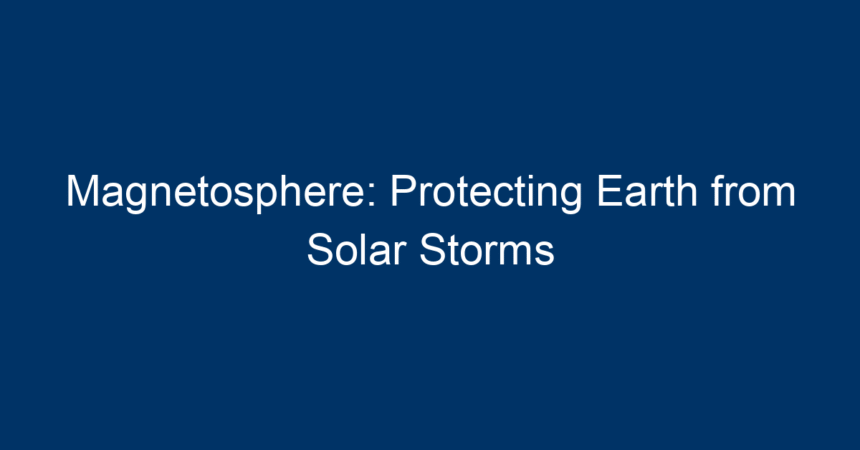The Earth is an extraordinary planet, but its survival hinges on a hidden fortress known as the magnetosphere. This dynamic shield plays a crucial role in safeguarding our atmosphere and civilizations from solar storms that could wreak havoc on our technology and daily lives. In this article, we will delve deep into what the magnetosphere is, how it functions, the threats posed by solar storms, and the preventative role the magnetosphere plays in maintaining the integrity of our planet.
Understanding the Magnetosphere
What is the Magnetosphere?
The magnetosphere is the region surrounding the Earth that is dominated by its magnetic field. Stretching out thousands of kilometers into space, this invisible barrier is formed by the Earth’s magnetic field, which is generated by the movement of molten iron in the outer core.
Structure of the Magnetosphere
The structure of the magnetosphere can be broken down into several distinct zones:
-
Bow Shock: The outermost layer, where the solar wind — a stream of charged particles released from the sun — meets the magnetosphere.
-
Magnetosheath: The region between the bow shock and the magnetosphere. It acts as a buffer, dissipating the energy and particles from solar winds.
-
Magnetopause: The boundary separating the magnetosphere from the solar wind, essential for regulating what enters the Earth’s magnetic field.
-
Plasmasphere: A region filled with low-energy plasma, forming a dense layer that helps protect Earth from solar radiation.
- Van Allen Radiation Belts: Two layers of charged particles trapped inside the magnetosphere, acting as an additional defense.
Function of the Magnetosphere
The primary function of the magnetosphere is to deflect solar wind particles, ensuring they do not directly impact Earth. This deflection occurs due to the magnetic field lines that stretch from the northern to southern poles. When solar winds approach, they interact with the magnetic field, causing them to be redirected away from the planet.
The Dangers of Solar Storms
What Are Solar Storms?
Solar storms are disturbances on the sun’s surface that can release large amounts of energy and charged particles into space. These events include solar flares and coronal mass ejections (CMEs), both of which have the potential to impact Earth.
Impact of Solar Storms
Solar storms can have several harmful effects:
-
Disruption of Communication Systems: The charged particles can interfere with satellite communications, GPS, and navigation systems, leading to failures and outages.
-
Power Grid Failures: The currents induced by solar storms can overload power grids, causing blackouts that may last for hours or even days.
- Increased Radiation Exposure: Astronauts and airline passengers on polar routes are at greater risk from radiation exposure during solar storms, which can affect health.
How the Magnetosphere Protects Us
The Shielding Mechanism
Every time a solar storm approaches Earth, the magnetosphere must react quickly to safeguard the planet. Here’s how it works:
-
Deflection of Charged Particles: When solar winds reach the magnetopause, the magnetic field lines become compressed, deflecting the charged particles away from the Earth.
-
Formation of Aurora: As some particles penetrate the magnetosphere, they interact with the Earth’s atmosphere, creating stunning visual displays known as auroras. Although beautiful, this is a sign of the energy released during these interactions.
- Energy Absorption: The magnetosphere can absorb and dissipate much of the energy from solar storms, protecting the atmosphere and the surface of the planet.
Historical Examples
Historically, there have been instances where solar storms have caused significant disruptions. The Carrington Event of 1859 is a prime example, where a massive solar storm led to telegraph failures and auroras seen as far south as Hawaii. Fortunately, the magnetosphere managed to protect the Earth from more severe consequences.
The Future of the Magnetosphere
Climate Change and the Magnetosphere
As researchers explore the impacts of climate change on our planet, understanding the magnetosphere’s role in climate regulation is becoming increasingly important. While the magnetosphere protects us from solar storms, its interaction with cosmic rays — which can be affected by solar activity — plays a role in cloud formation and climate systems.
Technology and Monitoring
With the rise of technology and solar activity predictions, monitoring systems like NASA’s ACE (Advanced Composition Explorer) and ESA’s Swarm satellites provide real-time data about solar winds. These systems help us anticipate solar storms and take necessary precautions.
Actionable Insights
Preparing for Solar Storms
While the magnetosphere does an excellent job of mitigating the effects of solar storms, here are some practical steps individuals and organizations can take to prepare:
-
Stay Educated: Understand the terminology surrounding solar storms and their potential impacts by following reputable sources like NASA and meteorological services.
-
Invest in EMP Protection: For those who rely heavily on electronic devices and systems, consider investing in electromagnetic pulse (EMP) protection to safeguard against possible disruptions.
-
Establish Communication Plans: In case of localized power outages, having backup communication plans can ensure continued interaction with loved ones.
- Monitor Space Weather: Utilize apps and websites that track solar activity and provide updates on potential impacts to better prepare for disruptions.
Conclusion
The magnetosphere is a remarkable and essential protective barrier that shields Earth from the dangerous effects of solar storms. Understanding its structure, function, and importance not only highlights the genius of natural processes but also emphasizes the interplay between celestial phenomena and life on our planet.
As technology advances and our reliance on electronic systems grows, maintaining awareness of solar activity and the role of the magnetosphere is more crucial than ever. By taking proactive measures and staying informed, we can ensure our resilience against the otherwise disruptive forces of solar storms.
In a world interconnected by technology, safeguarding our place in the cosmos relies heavily on this invisible shield. Let’s respect and appreciate the magnetosphere for its unwavering protection, reminding us of the intricate dance of forces that sustain our life on Earth.




